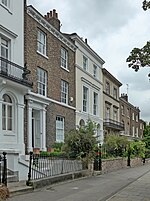Knavesmire
Execution sites in EnglandParks and commons in YorkUse British English from January 2017Villages and areas in the City of York

The Knavesmire is one of a number of large, marshy undeveloped areas within the city of York in North Yorkshire, England, which are collectively known as Strays. Knavesmire, together with Hob Moor, comprises Micklegate Stray. This place includes an area of execution known as York Tyburn. It has been suggested that the name 'Knavesmire' may share a derivation with Knaresborough—Cenward's mire.
Excerpt from the Wikipedia article Knavesmire (License: CC BY-SA 3.0, Authors, Images).Knavesmire
Trafalgar Street, York South Bank
Geographical coordinates (GPS) Address External links Nearby Places Show on map
Geographical coordinates (GPS)
| Latitude | Longitude |
|---|---|
| N 53.94204 ° | E -1.09812 ° |
Address
The Knavesmire
Trafalgar Street
YO23 1HX York, South Bank
England, United Kingdom
Open on Google Maps











